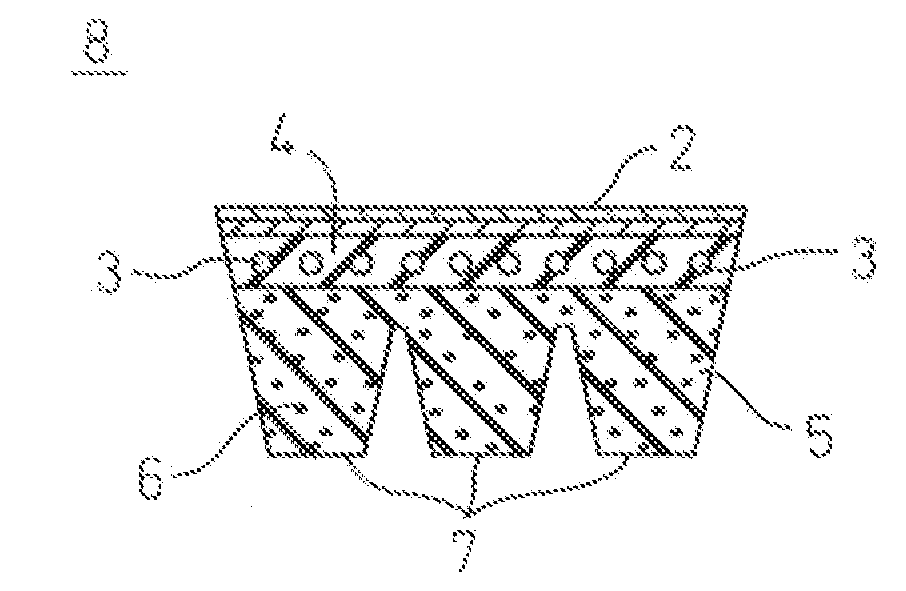Polyester fiber and method for its production, and tire cord, tire, belt-reinforcing fiber material and belt comprising the polyester fiber
a technology of polyester fiber and polyester fiber, which is applied in the direction of synthetic resin layered products, and non-conductive materials with dispersed conductive materials. it can solve the problems of insufficient dimensional stability or durability of belt reinforcing fibers, reduced strength or a lower modulus, and low variation in physical properties. , the effect of reducing the number of defects
- Summary
- Abstract
- Description
- Claims
- Application Information
AI Technical Summary
Benefits of technology
Problems solved by technology
Method used
Image
Examples
example 1
Production of Polyester Composition Chips
[0151]A mixture of 194.2 parts by weight of dimethyl terephthalate and 124.2 parts by weight of ethylene glycol (200 mol % to DMT), and 0.0735 part by weight of manganese acetate tetrahydrate (30 mmol % to DMT), were charged into a reactor equipped with a stirrer, rectification column and methanol distillation condenser. The temperature was then slowly raised from 140° C. to 240° C. while distilling out of the reactor the methanol that was generated by the reaction, to accomplish transesterification. After then adding 0.0522 part by weight of phenylphosphonic acid (33 mmol % to DMT), the transesterification reaction was suspended. There was then added 0.0964 part by weight of antimony trioxide (33 mmol % to DMT) to the reaction product, and the mixture was transferred to a reactor equipped with a stirrer, nitrogen inlet, pressure reduction valve and distilling apparatus. The temperature was subsequently raised to 290° C. for polycondensation ...
examples 2-8
[0159]A polyester polymer was obtained in the same manner as Example 1, except that the compound types and amounts were changed to those shown in Table 1, instead of the manganese acetate tetrahydrate and phenylphosphonic acid of Example 1. The results are summarized in Table 1.
[0160]Melt spinning and drawing were carried out in the same manner as Example 1 to obtain polyester fiber. The obtained fiber contained laminar nanoparticles, and no ordinary particulate metal-containing particles were observed.
[0161]Also, the limiting viscosity IVf reduction of the obtained fiber was low and the spinning speed for yarn breakage was very high. The fiber also had low variation in its properties of high tenacity, low stretch load (high modulus) and high elasticity. Moreover, despite the low dry shrinkage of the fiber, it had few fluff defects and a satisfactory spinning property. Particularly when phenylphosphonic acid was used, a satisfactory effect was exhibited even with a low content. The ...
example 9
[0162]After supplying a slurry comprising 166.13 parts by weight of terephthalic acid and 74.4 parts by weight of ethylene glycol into a polycondensation tank, esterification reaction was conducted at ordinary pressure, 250° C. to prepare bis(β-hydroxyethyl)terephthalate and its low polymers, at an esterification reaction rate of 95%. Next, 0.0735 part by weight of manganese acetate tetrahydrate (30 mmol % to TA) was added, and after stirring for 5 minutes, 0.0522 part by weight of phenylphosphonic acid (33 mmol % to TA) and 0.0964 part by weight of antimony trioxide (33 mmol % to TA) were added and the mixture was transferred to a reactor equipped with a stirrer, nitrogen inlet, pressure reduction valve and distilling apparatus. The temperature of the reactor was raised to 290° C. for polycondensation reaction at a high vacuum of below 30 Pa, to obtain a polyester composition. Chips were then prepared by a common method. The results are summarized in Table 1.
[0163]Melt spinning and...
PUM
| Property | Measurement | Unit |
|---|---|---|
| lengths | aaaaa | aaaaa |
| lengths | aaaaa | aaaaa |
| 2θ | aaaaa | aaaaa |
Abstract
Description
Claims
Application Information
 Login to View More
Login to View More - R&D
- Intellectual Property
- Life Sciences
- Materials
- Tech Scout
- Unparalleled Data Quality
- Higher Quality Content
- 60% Fewer Hallucinations
Browse by: Latest US Patents, China's latest patents, Technical Efficacy Thesaurus, Application Domain, Technology Topic, Popular Technical Reports.
© 2025 PatSnap. All rights reserved.Legal|Privacy policy|Modern Slavery Act Transparency Statement|Sitemap|About US| Contact US: help@patsnap.com



